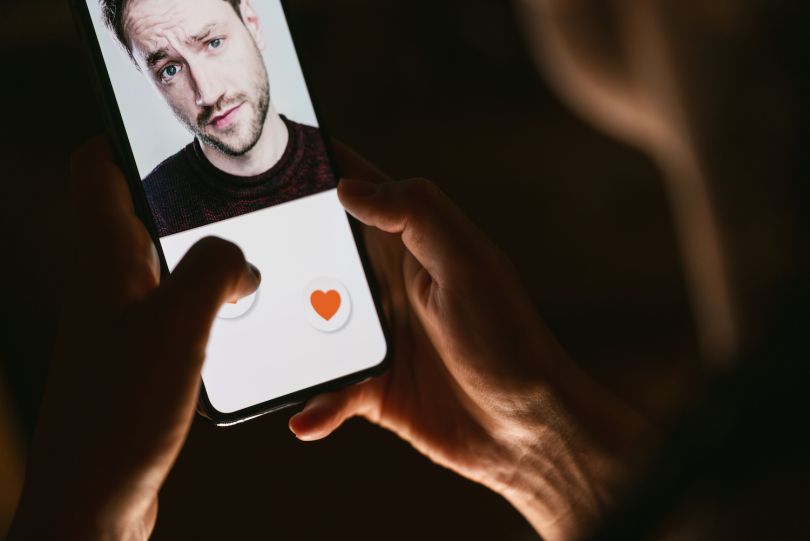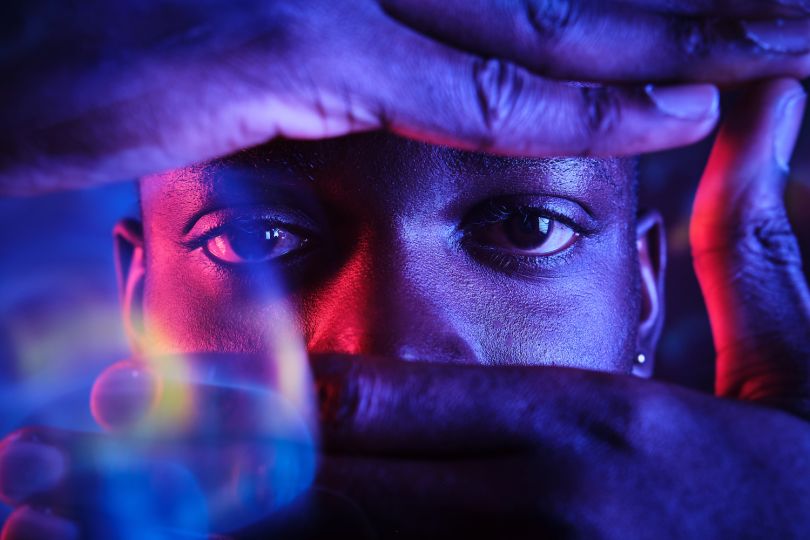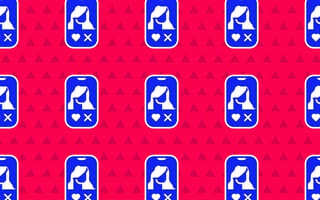Swipe right, you’re into them. Swipe left, you’re not.
That’s been the hard truth of dating apps for years. But Taly Matiteyahu and Laura Ciccone, the founders of Blink, an audio-only speed-dating app scheduled to launch this summer, believe it’s time for a paradigm shift.
“We’re used to swiping and looking at a profile and making decisions based on that.” Matiteyahu said. “And I think people are rethinking that strategy for online dating. The idea is to make a choice about whether or not you’re compatible based on an audio date.”
Admittedly, the app is something of a social experiment, described by Matiteyahu as “Love Is Blind” meets Clubhouse. For the uninitiated, the former is a Netflix matchmaking show in which the contestants, in their first few dates, can’t see one another. Talking to each other from behind a partition, they rely on the conversation to guide their romantic attraction — at least, that’s the show’s conceit. Clubhouse, for its part, is an invite-only audio meet-up app, which has drawn a ton of attention — both good and not so good — from the tech community and spawned spinoff features on Twitter and Facebook.
“The idea is to make a choice about whether or not you’re compatible based on an audio date.”
Though the concept for Blink Date actually predates the arrival of its apparent progenitors, it is premised on similar ideas. Like Clubhouse, the promise of the app’s design is rooted in the plausible theory that people are Zoomed out and find comfort in talking to one another without feeling they are on display. Like “Love Is Blind,” it calls into question, or at least complicates, Western assumptions about romantic attraction — principally, that love is founded on physical chemistry. Sure, love may be more than that, but physical attraction, the thinking goes, is the sine qua non of a flourishing, long-term relationship.
Not feeling any libido? Swipe left. It’s not going to end well.
But the thing is, it might. The first speed-dating pair on Date in a Blink, a podcast co-hosted by Matiteyahu and Ciccone as a proof of concept for the app, spent much of the time laughing and exchanging zingers about rude animals — the ice-breaker topic for the inaugural episode.
“Maybe it’s because I’m not a cat person,” Jon said, grumbling about feline hissing and scratching, “but I think they’re, like, trying to be one of those cool kids in high school and now I have to decide if I want to talk to them or not.”
Joy broke into laughter. “Have you been personally hurt by a cat in your life, because it sounds like you’re really harboring some cat resentment.”
In the 10-minute date, publicly available to anyone with a Spotify account, the two volunteer daters covered reality TV, Star Wars and their reasons for agreeing to appear on the show — all without seeing each other’s faces. At times, they also became quite earnest, like when they shared a moment lamenting the visual emphasis of modern dating apps.
“You’re essentially judging someone in a half-second window from the picture you see when they first pop up on your profile,” Joy said.

Swiping Decisions Are Often Based on Physical Appearance
That’s a big part of why the founders developed Blink. Their ambition for the app is to help make physical appearance — not just conventional “attractiveness,” but race, ethnicity, even fashion choices — a less important part of online dating.
But research suggests they may have a steep hill to climb. A series of mock swiping studies led by psychologist William Chopik at Michigan State University found that physical attractiveness and race were the largest predictors of selection decisions, with scores well above other factors like dating preferences and personality measures. Designed to mimic the swiping behavior on Tinder, the first phase of the four-part study used images culled from the University of Chicago’s Chicago Face Database to assess whether users would start a conversation with the person that might lead to a date.
Collectively, undergraduate students were more than four times as likely to swipe right on what the study deemed “attractive” profiles than less attractive profiles, and 2.7 times more likely to select people of the same race than a different race. The study was repeated with workers from Amazon’s Mechanical Turk crowdsourcing service with less dramatic but comparable findings.
“That people want to date attractive others is not particularly surprising,” the authors wrote. “But the degree to which physical attractiveness greatly dwarfed so many other characteristics, including the degree to which raters desired many casual sex partners, orientations toward relationships, how attractive raters considered themselves and the particular features of people’s faces (i.e., their symmetry and prototypicality) may be a little surprising.”
“That people want to date attractive others is not particularly surprising. But the degree to which physical attractiveness greatly dwarfed so many other characteristics ... may be a little surprising.”
One could argue swiping apps only amplify attraction biases that exist in the world. Research cited in Chopik’s paper shows people are more likely to date partners who are visually similar in physical attractiveness, body size, race and ethnicity. Perhaps the sheer number of options available on dating sites makes it easier for these preferences or biases to surface.
But that explanation only tells part of the story. Normally we see people in a broader context, Matiteyahu told me, where visual appearance isn’t such a dominant part of the equation. On dating apps, average users spend just three-to-seven seconds on a profile image before swiping — not a whole lot of time to explore someone’s beliefs and values.
“In terms of the unconscious bias, this is much more than just race and what someone’s skin color is,” Matiteyahu said. “It has a lot to do with someone’s hair color, if they’ve got tattoos or not, if they wear glasses, if they don’t wear glasses, their face structure, the types of photos that they’re putting online, are they posing with the fish or not. So there are all these different reasons that someone’s going to make assumptions about the other person.”
And, often, these assumptions are dead wrong.

Humor Is Attractive. But Attractive People Are Perceived as Humorous.
A separate series of studies, summarized in a journal article titled “An Evolutionary Perspective on Humor-Sexual Selection or Interest Indication,” examined perceptions of humor in sexual selection or interest, and found that humor does drive selection, but not in the way one might expect. When seeing someone before getting to know them, appearance may dictate how funny we perceive them to be, rather than allowing their sense of humor to build the attraction organically.
“The same exact joke can be perceived as highly funny or unamusing depending on who tells [it],” the authors noted. “‘You had to be there’ may be a suggestion to a secondhand audience that they lack the perspective needed to understand the exact relationship between the firsthand individuals.”
Just as Darwin’s sexual-selection theory has posited “the presence of ornamental traits in animal species, including the peacock’s intricate tail” as signs of reproductive fitness, rare traits involving complex brain functions like humor and artistic skill may be a way to show off to a potential mate, some scholars have surmised. But these authors’ interest-indication model suggests an alternative view: that attempts at humor and perceptions of it are complex signals designed to suss out romantic interest.
In other words, we tell more jokes around people we’re attracted to. They laugh more encouragingly if they’re attracted to us.
“Why is it that people are allowing themselves to use something that is so superficial when studies show there’s no correlation to whether this is going to be a long-term, successful relationship or not?”
The implication, of course, is that if a profile picture is not deemed attractive, a funny person may be rejected without getting their fair shake — a phenomenon that appears to be true across genders.
And there’s reason to believe dating apps may be missing the mark in ways beyond their visual emphasis. A 2017 study published in the journal Psychological Science used random-forest machine learning models to analyze whether psychological traits — including personality measures, well-being assessments, dating habits and values — identified before a four-minute speed date could predict peoples’ romantic desire after the date. The short answer is they could not.
“Why is it that people are allowing themselves to use something that is so superficial when studies show there’s no correlation to whether this is going to be a long-term, successful relationship or not?” Ciccone asked rhetorically.
Say Goodbye to Manicured Profiles
One explanation may be that online daters don’t want a long-term relationship: They want a quick, noncommittal romp. In their mock swiping study, Chopik and co-author David Johnson pointed out that “avoidant individuals might be more interested in forming superficial relationships as a way to engage in sexual activity without expectations of intimacy.”
But that approach only appears to represent a fraction of online daters. While Tinder may have inherited the label of a ‘‘hook-up” app (perhaps because it caters to younger users — their average age is 27) “the majority of participants report using Tinder to find a long-term partner,” the authors noted.
Still, apps like Tinder, Hinge and OkCupid are unquestionably visual. And for users who want less attention directed at their profile photos, or are wary of carefully scripted bios, Blink Date may serve up a more appealing formula.
First, it largely eliminates user profiles. During sign-up, members are asked to upload a single photo and provide basic details — such as their age, gender and sexuality, as well as lifestyle choices including their religion, political affiliation and whether they smoke or drink.
After submitting their availability for dates, members are algorithmically paired with potential dating partners based on the information they input during sign-up.
“There are no ‘leagues’ and we don’t have any algorithmic biases that have been identified in other apps (e.g. the algorithm showing me people it thinks I will like based on what others with a profile similar to mine like),” Ciccone claimed in an email.
During 10-minute speed dates, participants enter online rooms similar to Clubhouse’s, but with only two participants. Users are encouraged to take notes to remember their dates, should they eventually meet their conversation partner face to face.
“After the date ends, it’s sort of like getting out of Uber or Lyft,” Matiteyahu told me. “A little evaluation screen comes up and you indicate how the date went. And if it went well, that’s when we’ll show you the glances [of people’s photos].”

Anonymized Glances Make Appearance Less Important — and Selection More of a Gamble
“Glances” are perhaps the most intriguing part of the design. A collection of three-to-five anonymized photos revealed to users after they indicate the date went well, glances provide no indication of which photo represents the person the user just spoke with. (It could be any of the profile pictures the app serves up.) Users must decide if they’re willing to move forward with another date based on their interest in the group as a whole.
“You don’t know if you are rejecting the person you spoke with, if they’re rejecting you, or if they’re rejecting you based on your date or other factors.”
“It kind of leans into relationship psychology. If you have a connection with someone, your physical attraction will be higher,” Ciccone said.
“And it also leans into the concept of not wanting people to feel rejected,” Matiteyahu added. “You don’t know if you are rejecting the person you spoke with, if they’re rejecting you, or if they’re rejecting you based on your date or other factors. You only match if you rate the date and the glance positively.”
But won’t individuals secretly hope they match with a particular individual? I asked Matiteyahu. What if the person they’re paired with is not the person they hoped for?
“Maybe they’ll like all of them, we don’t know,” she told me.
If users do decide to move forward, the app reveals which face belongs to their most recent audio date.
“We’ll connect all the pieces for you — the profile photo, the sign-up details, along with your evaluation note,” Matiteyahu said.
Swipe Right and Swipe Left — but What About ‘Maybe’?
In a culture where psychographic data maps virtually every aspect of our lives, the mystery of romantic attraction may be part of the allure. Of the 32 daters recruited for the 16 podcast episodes, the overwhelming majority ranked their speed dates highly and said they would participate in audio-only speed dating again, Ciccone told me.
“I’m so intrigued by the whole speed date thing where you don’t get to see the other person, because when in real life would that happen?” Joy said during the podcast.
Jon, who confessed that dating apps weren’t his “cup of tea,” was equally enthusiastic about audio-only dating: “I’ve had enough experiences in my life to know that people who might not be on the cover of a magazine have personalities that would put them there,” he said. “I like to be mentally intrigued and challenged.”
The status of their relationship remains an enigma, but that will be revealed in a future podcast, Matiteyahu told me. Though the app has yet to be tested with enough users to gather statistically relevant data, analysis of the podcast shows 57 percent of daters were interested in a second meeting with their partner. Only 21 percent did not want to continue the conversation, with the remainder falling into the “maybe” category.
“Unlike most apps, which offer a binary, yes-or-no rating system, Blink allows users to say ‘maybe,’” Matiteyahu explained in an email. “This allows for matches that might otherwise not happen, including when the conversation was amazing and the person falls somewhere in the middle of our attraction spectrum (as opposed to the top), or the conversation was good, but nothing to write home about, and the person is at the top of our physical-attraction spectrum.”
“Unlike most apps, which offer a binary, yes-or-no rating system, Blink allows users to say ‘maybe.’”
And that “maybe” option might be what swiping apps are missing. As Western University psychology professor Samantha Joel and her co-authors observed in their machine learning study of attraction, romantic compatibility is still something algorithms have a hard time sorting out.
“Is romantic desire like a chemical reaction, such that the right combination of traits and preferences from two people will predictably result in strong levels of desire?” they wrote in the concluding discussion. “Or, is it more like an earthquake, such that the dynamic and chaos-like processes that cause its occurrence require considerable additional scientific inquiry before prediction is realistic? The current study suggests that the latter may be more likely than the former.”
For Matiteyahu, who was recently selected to participate in Project Two.Eight, a Columbia University Women’s Initiative program that provides women founders with access to early-stage startup support, that’s an encouraging finding. As she and Ciccone prepare for a summer launch in Los Angeles and a fall release in New York City, the founders are hoping the latitude of Blink’s design will give users a choice beyond simply swiping right or left. Some relationships, it seems, need time to steep.
“People feel like the dating market is very stale right now and that there are many ways they can game the system,” Matiteyahu said. “Those looking for something more serious don’t really want their dating experience to be fully gamified. They want easy ways to meet people. And they want ways that they can get to know the person behind the profile.”




